Möchten Sie Gutenberg (Block-Editor) deaktivieren und den klassischen WordPress-Editor auf Ihrer Seite behalten?
Gutenberg ist der Standard-Block-Editor in WordPress, der den klassischen WordPress-Editor ersetzt hat. Viele Nutzer finden es schwierig, sich daran zu gewöhnen und würden lieber den klassischen Editor behalten.
In diesem Artikel zeigen wir Ihnen, wie Sie Gutenberg einfach deaktivieren und den klassischen Editor in WordPress behalten können.
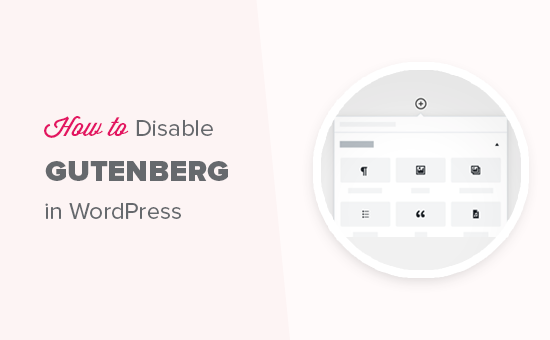
Was ist Gutenberg?
Gutenberg ist der Entwicklungsname für den Block-Editor in WordPress. Der Block-Editor wurde mit dem Ziel entwickelt, das WordPress-Schreiberlebnis zu modernisieren.
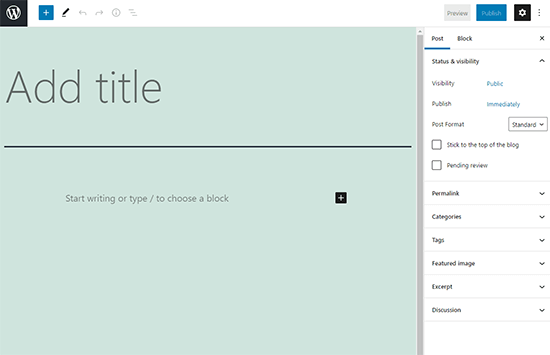
Es versucht, wie ein Seitenerstellungs-Plugin zu funktionieren, und ermöglicht es Ihnen, Elemente per Drag & Drop in einen Beitrag oder eine Seite zu ziehen. Das Ziel ist es, mehr Flexibilität zu bieten und WordPress-Benutzern zu ermöglichen, einzigartige Layouts für ihre Inhalte mit reichhaltigen Multimedia-Inhalten zu erstellen.
Seit der Veröffentlichung von WordPress 5.0 ist der Block-Editor nun der Standard-Editor in WordPress.
Warum den Gutenberg-Editor in WordPress deaktivieren?
Viele Nutzer, die WordPress schon seit Jahren verwenden, sind mit dem klassischen Editor besser vertraut.
Da der Block-Editor noch relativ neu ist, sind einige Plugins noch nicht mit ihm kompatibel.
Glücklicherweise gibt es ein Plugin des WordPress-Kernteams, mit dem Sie den klassischen Editor auch unter WordPress 5.0 oder später verwenden können.
Schauen wir uns an, wie Sie Gutenberg ganz einfach deaktivieren und weiterhin den klassischen WordPress-Editor verwenden können.
- Methode 1. Gutenberg mit dem WPCode-Plugin deaktivieren (empfohlen)
- Methode 2. Deaktivieren Sie Gutenberg mit dem Classic Editor Plugin
- Methode 3. Verwenden Sie den klassischen Editor mit dem Plugin Gutenberg deaktivieren
Methode 1. Gutenberg mit dem WPCode-Plugin deaktivieren (empfohlen)
Wir von WPBeginner empfehlen, Gutenberg mit dem WPCode-Plugin zu deaktivieren.
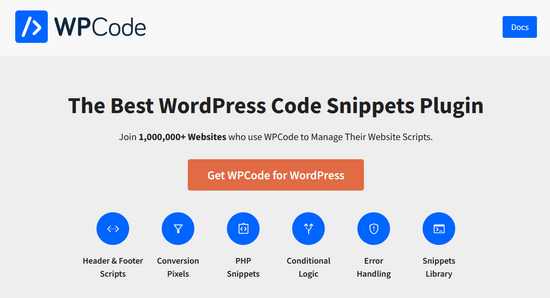
WPCode ist das beste Code Snippets Plugin für WordPress. Es macht es einfach, benutzerdefinierten Code in WordPress hinzuzufügen, ohne die functions.php-Datei Ihres Themes bearbeiten zu müssen.
WPCode verfügt außerdem über eine integrierte Code-Snippets-Bibliothek, mit der sich WordPress-Funktionen leicht anpassen lassen.
In der Bibliothek finden Sie geprüfte Code-Snippets für beliebte Funktionsanforderungen wie Gutenberg deaktivieren, WordPress REST API deaktivieren, automatische Updates deaktivieren und vieles mehr.
Dadurch entfällt die Notwendigkeit, eine Reihe von Plugins für den einmaligen Gebrauch zu installieren.
Um loszulegen, müssen Sie das kostenlose WPCode-Plugin installieren und aktivieren. Wenn Sie Hilfe benötigen, finden Sie in unserer Anleitung zur Installation eines WordPress-Plugins eine Schritt-für-Schritt-Anleitung.
Sobald das Plugin aktiviert ist, gehen Sie in Ihrem WordPress-Dashboard zu Code Snippets „ Library.
Suchen Sie dann nach dem Snippet „Gutenberg-Editor deaktivieren (klassischen Editor verwenden)“ und klicken Sie auf die Schaltfläche „Snippet verwenden“.
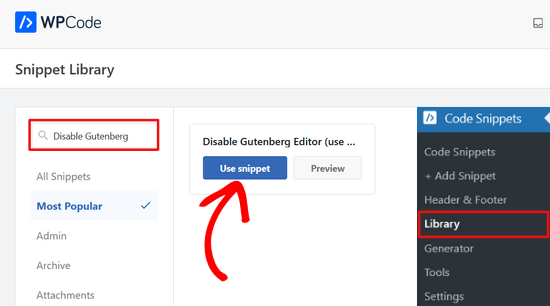
Dann fügt WPCode den Code automatisch ein, legt die richtige Einfügemethode fest und fügt einen Titel und Tags hinzu, damit Sie sich merken können, wofür der Code ist.
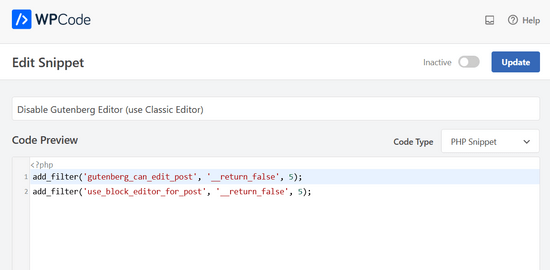
Dazu müssen Sie lediglich den Schalter von „Inaktiv“ auf „Aktiv“ umlegen.
Klicken Sie anschließend auf die Schaltfläche „Aktualisieren“.
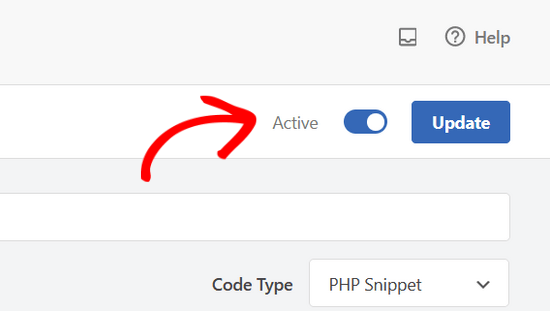
Das war’s. Der Gutenberg-Block-Editor ist jetzt deaktiviert und Sie können den klassischen Editor verwenden.
Methode 2. Gutenberg mit dem Classic Editor Plugin deaktivieren
Für diese Methode werden wir das Classic Editor Plugin verwenden, das von den Hauptakteuren von WordPress entwickelt und gepflegt wird.
Als Erstes müssen Sie das Classic Editor-Plugin installieren und aktivieren. Weitere Details finden Sie in unserer Schritt-für-Schritt-Anleitung zur Installation eines WordPress-Plugins.
Das Plugin ist sofort einsatzbereit und deaktiviert den Gutenberg-Editor bei der Aktivierung.
Dieses Plugin gibt Ihnen auch die Möglichkeit, Gutenberg und den klassischen Editor gleichzeitig zu verwenden. Sie können dies in den Einstellungen des Plugins konfigurieren.
Gehen Sie einfach auf die Seite Einstellungen “ Schreiben in Ihrem WordPress-Verwaltungsbereich. Sie finden die entsprechende Option unter „Klassische Editoreinstellungen“.
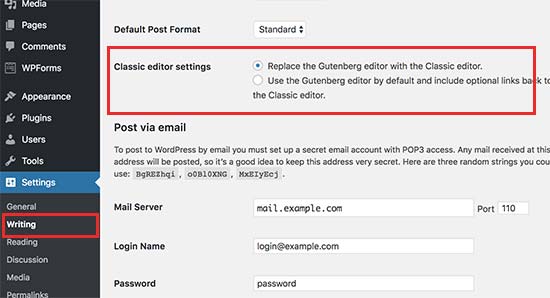
Vergessen Sie nicht, auf die Schaltfläche „Änderungen speichern“ zu klicken, um Ihre Einstellungen zu speichern.
Unter dem Menü “ Beiträge“ finden Sie nun einen neuen Link, über den Sie neue Beiträge mit dem klassischen Editor erstellen können.
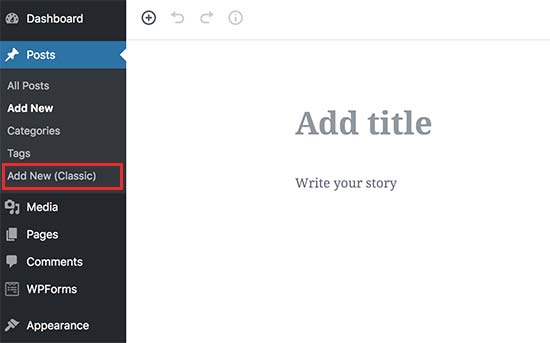
Sie können ältere Beiträge auch mit dem klassischen Editor bearbeiten. Gehen Sie einfach auf die Seite Beiträge “ Alle Beiträge und Sie werden einen Link „Bearbeiten (klassisch)“ unter den Beiträgen sehen.
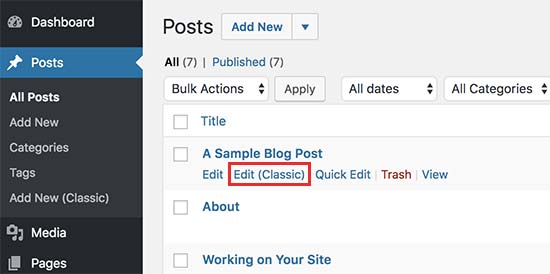
Methode 3. Klassischen Editor mit deaktiviertem Gutenberg-Plugin verwenden
Wenn Sie Gutenberg für bestimmte Benutzerrollen und Beitragstypen deaktivieren möchten, können Sie dies mit dieser Methode tun.
Zunächst müssen Sie das Plugin “ Disable Gutenberg “ installieren und aktivieren. Weitere Details finden Sie in unserer Schritt-für-Schritt-Anleitung zur Installation eines WordPress-Plugins.
Nach der Aktivierung müssen Sie die Seite Einstellungen “ Gutenberg deaktivieren besuchen, um die Plugin-Einstellungen zu konfigurieren.
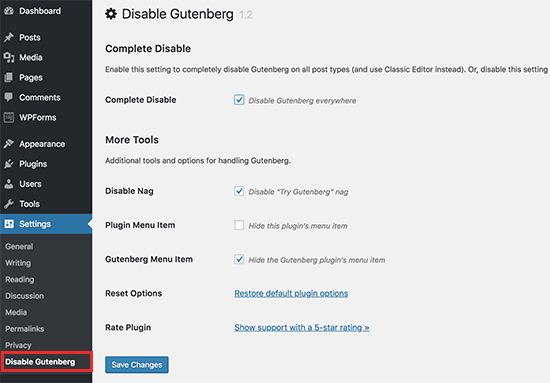
Standardmäßig deaktiviert das Plugin Gutenberg überall für alle Benutzer auf Ihrer Website. Wenn Sie es jedoch auf bestimmte Benutzerrollen und Beitragstypen beschränken möchten, müssen Sie die Option „Vollständige Deaktivierung“ deaktivieren.
Wenn Sie das Häkchen entfernen, werden weitere Optionen angezeigt, um Gutenberg für bestimmte Benutzerrollen, Beitragstypen, Themenvorlagen oder einzelne Beiträge selektiv zu deaktivieren.
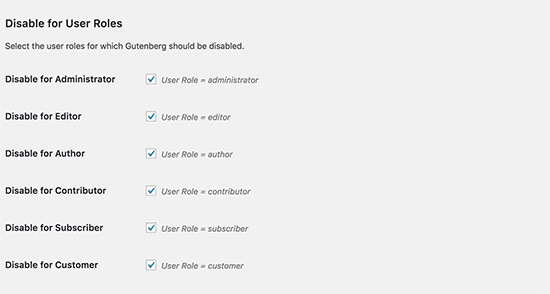
Diese Option ist hilfreich, wenn Sie ein WordPress-Plugin verwenden, das nicht mit Gutenberg kompatibel ist, Sie Gutenberg aber für andere Bereiche Ihrer Website verwenden möchten.
WordPress ist der weltweit beliebteste Website-Builder, der mehr als 43 % aller Websites im Internet betreibt.
Es verfügt über Tausende von Plugins und Themes und versorgt alle Arten von Websites, von eCommerce-Shops bis hin zu Mitglieder-Communities.
Viele dieser Plugins sind jetzt mit dem Block-Editor kompatibel. Zum Beispiel enthält WPForms einen benutzerdefinierten Kontaktformular-Block, so dass Sie Ihre Formulare leicht in jeden Beitrag oder jede Seite mit dem Block-Editor einfügen können.
Viele Tools von Drittanbietern basieren jedoch immer noch stark auf dem klassischen WordPress-Editor und sind möglicherweise nicht vollständig mit dem Block-Editor kompatibel.
Wenn das der Fall ist, könnten diese Einstellungen sehr hilfreich für Sie sein.
Vergessen Sie nicht, auf die Schaltfläche „Änderungen speichern“ zu klicken, um Ihre Einstellungen zu speichern.
Wir hoffen, dass dieser Artikel Ihnen geholfen hat, Gutenberg zu deaktivieren und den klassischen Editor in WordPress beizubehalten. Vielleicht interessiert Sie auch unsere Liste der unverzichtbaren WordPress-Plugins für alle Websites und unser Vergleich der besten E-Mail-Marketingdienste für kleine Unternehmen.
Wenn Ihnen dieser Artikel gefallen hat, dann abonnieren Sie bitte unseren YouTube-Kanal für WordPress-Videotutorials. Sie können uns auch auf Twitter und Facebook finden.





Syed Balkhi says
Hey WPBeginner readers,
Did you know you can win exciting prizes by commenting on WPBeginner?
Every month, our top blog commenters will win HUGE rewards, including premium WordPress plugin licenses and cash prizes.
You can get more details about the contest from here.
Start sharing your thoughts below to stand a chance to win!
Moinuddin Waheed says
classic editor has been great for writing content and specially for bloggers where the main aim is to publish regular content.
moreover, making table is a lot of easier when it comes to classic editor whereas Gutenberg editor still lags flexibility in table customisations.
I had to use classic editor mainly for making table.
Is there a way we can have both the editors and can make a switch to utilise the best features of both the editors?
or will we need to disable one to use the other?
WPBeginner Support says
You would need to only use one editor at a time as swapping editors can cause formatting issues.
Admin
mohadese esmaeeli says
One of the issues with Gutenberg that has bothered me is the absence of the ‚Show Revisions‘ feature, which is available in the classic editor. Another problem is that Ctrl+Z doesn’t work in this editor, and I’m always afraid that my writing might be lost due to an internet interruption, WordPress hang-ups, or any other reasons.
Ahmed Omar says
As a new beginner on wordpress, I found that classic editor is easy for me to use.
Should I continue using it or I should train myself to use block editor from now
WPBeginner Support says
If possible it would be good to start learning the block editor as WordPress updates there will be more and more added to the block editor.
Admin
Tikyda says
Thanks a lot. I did not know it could be so quick to get rid of the new wordpress text editor. I used the plugin you recommended.
WPBeginner Support says
Glad our guide was helpful!
Admin
VickyR says
WOW! Did this article „find me“ at the right time! I think this is the best WordPress site on the internet, have been following it a long time and decided put foot in the waters and test a new site with WordPress 6.0.1 (local install). The toggle button popping up and hiding all the dashboard options was driving me crazy every time I tried to create a new page or post! Have been sitting here all day trying to figure out stop the Dashboard menu from dissappearing. Didn’t realize it was Gutenberg vs Classic Editor. THANK YOU SO MUCH FOR THIS POST wpbeginner!


WPBeginner Support says
Glad to hear our article was helpful!
Admin
Theresa Southern says
Seems to be working like a charm! Thanks for the tip!
WPBeginner Support says
Glad to hear it is working for you!
Admin
Frances Sinclair says
Unfortunately I can’t install the plugin as it requires me to have a Business Plan. I know I had plugins on my blogs but can’t install any now. Have been forced into block editor.
WPBeginner Support says
To clarify, our tutorials are for WordPress.org sites, you can see the difference between the two in our article below:
https://www.wpbeginner.com/beginners-guide/self-hosted-wordpress-org-vs-free-wordpress-com-infograph/
We also have a free transfer service should you be interested in moving your site from WordPress.com to WordPress.org.
Admin
Brigitte says
Hi, I’ve downloaded the plug in for the classic Editor since I couldn’t figure out how to Indent paragraph in the Block editor. I’m now able to „indent“ a paragraph in the Classic Editor. I then save the Classic editor and close it.
However, as soon as I open the Classic Editor, my „indents“ are gone (Even though I had saved my post)? I’m used to the Block Editor, but it’s missing some functionalities (like indents). Not sure what to do? I prefer not to use the Classic Editor too much, only for the missing functionalities. Can we not use both?
WPBeginner Support says
You would not want to swap between editors as that can cause different issues like the one you are running into. For those situations, you would want to use the Classic block for that styling or stay in the classic editor.
Admin
John says
Hi,
installing the classic editor was easy on WP 5.6
Only thing is that the classic „look“ is not there ? It has a different interface ?
WPBeginner Support says
You would want to ensure you’ve enabled the classic editor in the plugin’s settings for it to be visible.
Admin
Angelina says
I’m using wordpress.org, but when I go to the writing settings this option isn’t there..? I’m not sure what I’m doing wrong
WPBeginner Support says
You would want to ensure the plugin is installed and activated for the option to be available.
Admin
Frank White says
I’m using WordPress COM. On Oct 1, 2020 when I added a post to my blog I was shocked to discover that the familiar Classic interface had been replaced by Gutenberg without my permission.
Even worse, when I tried to restore the Classic interface I got this message — „To install plugins you need to upgrade to a business plan.“
WPBeginner Support says
You would need to reach out to WordPress.com’s support for what the current options that they have available are without upgrading to be able to use plugins. Our guides are for WordPress.org sites currently.
Admin
Matt says
On free plans, you can’t install the plugin, but it’s still possible to use the old editor. Go to the WP Admin page which is located at blogname.wordpress.com/wp-admin. Click Posts->All Posts to get a list of your posts. If you hover over a post title, you can choose Classic Editor below it. Note: This may not work if your WP account is new.
Pam says
Thank you for this plugin. I’ll want to create blog posts again, thanks to this plugin!
WPBeginner Support says
Glad our recommendation was helpful
Admin
Hendrik says
Hi,
I recently updated my site to WP 5.5.1 – no choice, but Gutenberg. When I install the Classic Editor plugin, the article previews get a 404 error. Any ideas, whether it’s the theme or other plugins interferring?
WPBeginner Support says
It would depend on what you have on your site, you would want to follow the steps in our article below for how to troubleshoot an error like this:
https://www.wpbeginner.com/beginners-guide/beginners-guide-to-troubleshooting-wordpress-errors-step-by-step/
Admin
Mark says
I happened to do a fresh WP installation last night and noticed that block editing is the default status as now the block editor is built into the WP core. A couple years ago I installed the Gutenberg plugin. Is it possible to uninstall the plugin and retain the block editor or will uninstalling the Gutenberg plugin disable block editing? It would be a disaster to uninstall it and find pages and posts created with the Gutenberg plugin all in a mess.
WPBeginner Support says
If your site is up to date you should be able to uninstall the Gutenberg plugin safely.
Admin
Heather Davis says
Hi. I have been using the Classic Editor plugin, but isn’t there an expiration to that? I thought I remember they will require everyone to move over to Gutenburg by a certain date. Do you know about this?
I ask because I was going to hire someone to recreate my blog in Gutenburg blocks… because I thought I had to eventually. But I don’t want to do the dust has settled on Gutenburg and all the kinks are worked out.
Advice?
WPBeginner Support says
They mention this on the Classic editor plugin page itself. Currently, the plugin will be supported until 2022, or as long as necessary.
Admin
Michael says
The new block editor sucks.
WPBeginner Support says
Some people think that which is why the Classic Editor plugin is available, should you not want to use the block editor you can use that plugin. We would recommend trying the block editor when you can as it has improved over time.
Admin
ali says
tnq for sharing this amazing information, that’s work wonderful for me
WPBeginner Support says
You’re welcome, glad our guide was helpful
Admin
Bapan Mistri says
Thanks a lot for the information.
WPBeginner Support says
You’re welcome
Admin
Dharmesh Patel says
Great post. It helped me a lot.
WPBeginner Support says
Thank you, glad our tutorial was helpful
Admin
ValerieB says
I’ve read the post above and do not see these options when I look at settings on my 2nd site. When I choose plug-ins, I get the message that I have to upgrade to a paid plan in order to be able to use either the disable gutenberg plugin or the classic editor plugin.
Is this correct? People with free sites are not allowed to disable the „new block editor“? Thank you.
WPBeginner Support says
Our tutorials are for WordPress.org sites, not WordPress.com sites. WordPress.com should be able to let you know the options available but they may have an option in the top right of the post editor unless it has been removed
Admin
Cheryl says
In trying to find a way out of Gutenberg I installed Classic Editor, also Classic Editor add-on, and then finally Disable Gutenberg. A third party tool I used to use used to work perfectly for months. Now it does not, even with this plugins. Do I have too many plugins at this point? Suggestions? Thank you.
WPBeginner Support says
You would only want one plugin for the classic editor active, you may be running into a conflict between the plugins that is preventing the classic editor from displaying.
Admin
Sameer Kumar says
I have followed all the processes but my problem is not yet resulted.
WPBeginner Support says
If neither of these plugins was able to revert you to the classic editor, you may want to disable your other plugins to ensure this isn’t a plugin conflict.
Admin
Le Hunt says
Thank you, I don’t like Gutenberg at all, and was able to get my website, which I’m still working on, back to normal.
WPBeginner Support says
Glad our guide can help, as Gutenberg evolves the editing experience should improve for the future
Admin
Aimee says
You cannot install ANY plugins on WordPress if you don’t „upgrade to the business plan“ as is what happens when you go to the plugin page. For the zillions of us who have blogs on there and are forced into the block editor, what do we do?
WPBeginner Support says
To clarify, our tutorials are for WordPress.org sites, not WordPress.com sites: https://www.wpbeginner.com/beginners-guide/self-hosted-wordpress-org-vs-free-wordpress-com-infograph/
If you click the three vertical dots in the top right of the editor they may have the option to swap to the classic editor.
Admin
Andrew says
Gutenberg is very annoying. Add the below code to your theme function file
add_filter(‚use_block_editor_for_post‘, ‚__return_false‘);
Save and have fun.
WPBeginner Support says
That is one method, we recommended the plugins as those are easier for beginners to disable if they would like to use the editor in the future
Admin
Michele Hollick says
I’ve been using the Classic Editor for awhile now and it works great. Some of my editing features are missing though. There is no longer an option to change the color or font size and underline is missing too. Is there a way to fix that?
WPBeginner Support says
Those were likely added by the tinyMCE Advanced plugin if you were using that previously
Admin
Dieter says
Thanks! Your post about the classic editor plugin solved my issue with new default editor of WordPress immediately!
WPBeginner Support says
Glad our guide was helpful
Admin
Mada says
Just started panicking when first saw this update! But now I’m back on track! Thank you so much!
WPBeginner Support says
Glad our guide could help
Admin
Karina says
Thanks, this worked for me. Horrible wordpress update
WPBeginner Support says
Glad our recommendation worked, it is continuing to be developed so as it is worked on the editing experience should improve
Admin
Brooke says
I gave myself two weeks to adjust to this and reinstalled the old editor months ago on my personal site. Now I’m having to work with it again for a client and man do I hate this editor.
WPBeginner Support says
There is a learning curve but this editor should hopefully reduce the barrier to entry for new users to WordPress
Admin
elena says
I used your method and it worked instantly… after hours of despair!
Super Mega Thank you!!!
Would you have any estimated idea of when wordpress developer intend to force everyone to use the Gutenberg editor?
Where best to leave them feedback?
It messes up my whole website structure and all of a sudden pictures disappeared from post without me being able to access.
WPBeginner Support says
The classic editor plugin plans to be officially supported until December 2021 at the moment. If you visit the Gutenberg plugin page they have information on how to leave feedback
Admin
Mario Boutin says
THank you for the article. I have searched for hours trying to get my drafts saved and my posts published with no success. I even played the permissions in the files sections of my cPanel. Nothing worked until after many searches through WordPress forums and after reading 10’s of Google suggestions on „How to get my posts saved“ or „Posts won’t save in WordPress“ I finally found your article and I didn’t know that was so simple to solve that problem. I simply installed the plugin Classic Editor and it worked right away! Thanks again!
WPBeginner Support says
Glad our article could help
Admin
Marialena Sarris says
Thank you for the informative article. The new editor is the most time consuming and complicated editor ever, (this thing is unresponsive and lugs continuously) which they shoved it to our throats. forcing us to run yet another plugin, for something that didn’t need a plugin in the first place.
Thank you again for the article.
WPBeginner Support says
There are certainly parts that are works in progress, as it improves it should hopefully help new users to WordPress
Admin
Solomon Mwale says
Thank you so much for sharing this information I have been off my blog for long.
Today I was trying to post something and I got stuck with this.
But after a very long search, I have finally managed to get the results that I wanted and finally on the read again.
Keep on sharing this great information all the time you are such a great help.
WPBeginner Support says
You’re welcome, glad our content could be helpful
Admin
Brick Wall says
Excellent information!! Thank you. As of 20180321 a couple of the menu items listed above have been removed but other than that this was a life saver for editing previous content. Outstanding!
WPBeginner Support says
Thank you for letting us know
Admin
manuel says
Thanks, thanks, thanks. The Gutenberg editor is a nightmare, headache and time consuming.
WPBeginner Support says
Glad our article could help return you to the editor you were accustomed to
Admin
Alec says
Thank you so much for showing me the way out of my Gutenberg Nightmare. What on earth are the WP development team thinking?!?!?
WPBeginner Support says
It can certainly be confusing if you’re accustomed to the classic editor but it is the current attempt to make creating a post on WordPress more beginner friendly.
Admin
Lisa Alford says
Was having so much trouble with Gutenberg I wasn’t blogging anymore. The work around you showed wasn’t appearing on my „writing“ page. There was no option for Classic Editor on there. I had to reinstall Classic Editor. YAY!!! Back up and off to work I go!
WPBeginner Support says
Glad you were able to get it working again
Admin
Keith Berger says
Thank you SOOOOOOOOOOOO much for this!!! The new editor ought to be called Clunky Anxiety Producer. Your article just gave me my blogging life back!
thanks you! <3
<3
WPBeginner Support says
Glad our article could help
Admin
Ben says
Ive been experiencing issues with the editors today. We had the Classic editor installed on a few sites but two of them will now not change to text tab view from visual tab in the editor screen. Both have Bakery visual builder plugin installed which i thought might be the issue but even when disabling that plugin i still have same issue. Ive tried both suggested plugins and get the same results. Im now looking for any other option as really dont want to use Guttenburg. Any ideas would be gratefully received. Thanks.
WPBeginner Support says
We would recommend first reaching out to the support for the classic editor plugin to see if this is a known issue or if they have a recommended solution.
Admin
SgtDeathAdder says
Gutenberg was a nightmare to me, so many issues with it. Thanks for your article it really helped!
WPBeginner Support says
Glad our recommendation could help
Admin
ethan says
Thank God for Classic Editor!!!!! Hahahaha. The new WP was a culture shock for me when I went back to blogging.
WPBeginner Support says
Glad we could let you know about this plugin
Admin
ClemzyBoss says
I had to Install the Uninstall Gutenberg plugin..thanks a whole lot!
WPBeginner Support says
Glad our article could help and you found a plugin that worked for you
Admin
Janni says
Oh, Thank you very much! It works like charm! I love you! You save me from so much stress. You’re a lifesaver. It works like charm.
WPBeginner Support says
Glad our guide could help
Admin
Alex says
Thank you for the instructions! We went with option 1 and it put us back on the classic editor. Worked like a charm!
Thank you!
WPBeginner Support says
Glad our article could help
Admin
Ed says
I have tried all of the instructions offered above and unfortunately for me, any page that i open to edit with classic editor contains nothing but red wavy lines. I do not have time to try more failed suggestions, so please tell me how to revert back to a previous word press version that worked as advertised.
Thank you.
WPBeginner Support says
Sadly, at the moment we do not have a recommended method for reverting your WordPress version. If you have a backup of your site you should be able to restore it using:
https://www.wpbeginner.com/beginners-guide/beginners-guide-how-to-restore-wordpress-from-backup/
We would also recommend letting the support for the Classic Editor plugin know about your issue and they may be able to assist.
Admin
Estefania Campoblanco says
Hi, I’m currently taking way longer than intended whenever I’m writing a new post. My editing tool bar doesn’t have the tools i need it to have and is very limited, as it seems to be not compatible with the puglin I downloaded for it to adjust to my needs. As I was half through a post when I decided to install the new version of WordPress, it wasn’t as hard to use because i had little work left to do. So my question here is: if I download the classic editor, will my published post (that used images blocks) remain the way it is right now? Or will it be altered when i switch back to classic one?
Thank you,
WPBeginner Support says
Hi Estefania,
Some design elements may not appear as they did in new editor.
Admin
Magnus Andersson says
Gutenberg is a disaster and it seriously inhibits my workflow. Thanks for your great advice.
Jeffrey Fry says
Installing the „Classic Editor“ plugin worked like a charm. Automatically disabled gutenberg editor.
Editorial Staff says
Glad you found that helpful Jeffrey
Admin
Dann says
Thanks! The new editor is horrid!!